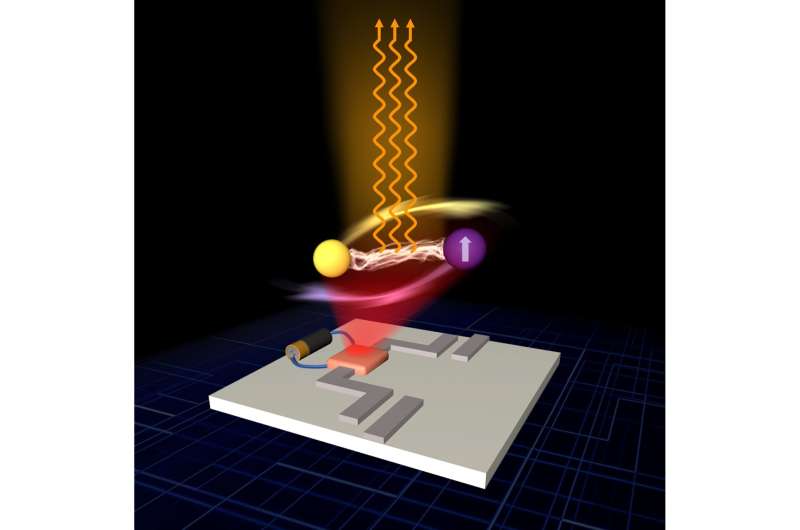May 5, 2023 feature
This article has been reviewed according to Science X's editorial process and policies. Editors have highlighted the following attributes while ensuring the content's credibility:
fact-checked
peer-reviewed publication
trusted source
proofread
A highly performing device for polariton-based coherent microwave emission and amplification

When light strongly interacts with matter, it can produce unique quasi-particles called polaritons, which are half light and half matter. In recent decades, physicists explored the realization of polaritons in optical cavities and their value for the development of highly performing lasers or other technologies.
Researchers at University of Manitoba recently developed a highly performing device based on cavity magnon polaritons that can emit and amplify microwaves. This device, introduced in Physical Review Letters, was found to significantly outperform previously proposed solid-state devices for coherent microwave emission and amplification at room temperature.
"In 1992, Claude Weisbush, a French semiconductor physicist working in Japan, discovered cavity exciton polariton by confining light in a quantum microcavity to interact with semiconductors," Can-Ming Hu, the researcher who directed the study, told Phys.org.
"This led to the invention of polariton lasers with superior performance that have transformed solid-state laser technology. Two decades later, the magnetism community re-discovered cavity magnon polariton by confining microwaves in a cavity to interact with magnetic materials, such a half photon and half magnon quasi-particle was first discovered by Joe Artman and Peter Tannenwald in 1955 at MIT, which went largely unnoticed until recently."
Wireless communication and quantum information technologies require coherent on-chip microwave sources. Motivated by this need, Hu and his colleagues set out to explore the potential use of cavity magnon polaritons to achieve high-quality microwave emission and amplification.
"Intrigued by the resemblance between cavity magnon polariton and cavity exciton polariton, I became curious whether the cavity magnon polariton might help us to make better solid-state microwave sources," Hu said. "So, in 2015, my group launched a study to explore microwave emission of cavity magnon polaritons."
The researchers initially set out to create a light–matter coupled system based on cavity magnon polaritons for coherent microwave emission. They ultimately hoped to achieve a higher performance than those reported in previous works, while retaining their device's stability and controllability as a hybrid light–matter coupled system.
"First, we follow the principle proposed in 1920 by Dutch physicist van der Pol: using nonlinear damping to balance gain in an amplified oscillatory system, one can design and optimize a stable gain-driven cavity," Bimu Yao, an associate professor from the Chinese Academy of Sciences who carried out this study at the University of Manitoba, told Phys.org. "Then, we set a magnetic material into such a gain-driven microwave cavity, letting the amplified microwaves to strongly interact with magnons."
The strong interaction between amplified microwaves and magnons in the researchers' system produces a new type of polariton, which they dubbed a "gain-driven" polariton. Compared to conventional polaritons realized in previous studies, this gain-driven polariton has a stable phase, which in turn enables the coherent emission of microwave photons.
"For decades, the magnetism community has been working on spin-toque oscillator (STO), which is a solid-state device that utilizes magnons to produce coherent microwaves," Yongsheng Gui, a research associate at the University of Manitoba who carried out the study, told Phys.org. "The major hurdle is that the emission power of the STO is typically limited to less than 1 nW. Our device's output is a million times more powerful, and the emission quality factor is a thousand times better."
In initial evaluations, a proof-of-principle device created by this team of researchers achieved remarkable results, outperforming both STOs and solid-state masers developed in the past. Masers are devices that use the stimulated emission of radiation by atoms to amplify or generate microwave radiation.
"Outside of the magnetism community, there have been divers efforts for developing masers," Gui said. "Compared with the best solid-state maser, our device's output is a billion times more powerful, with a comparable emission quality factor."
The new gain-driven polariton realized by Hu and his colleagues could open exciting new possibilities for the development of highly performing solid-state microwave sources that can be integrated on-chip. In addition to their compact sizes, these polariton microwave sources are frequency tunable due to the fabulous controllability of light-matter interaction. They could ultimately be integrated in a broad range of technologies and devices, including wireless communication systems and quantum computers.
"As the physics of gain-driven light-matter interaction is new, our study may also lead to new discoveries beyond microwave applications," Hu added. "We have now submitted a patent application, and my students are working on developing prototype devices together with industry partners."
More information: Bimu Yao et al, Coherent Microwave Emission of Gain-Driven Polaritons, Physical Review Letters (2023). DOI: 10.1103/PhysRevLett.130.146702
Can-Ming Hu, Dawn of Cavity Spintronics, arXiv (2015). DOI: 10.48550/arxiv.1508.01966
Journal information: Physical Review Letters , arXiv
© 2023 Science X Network





















